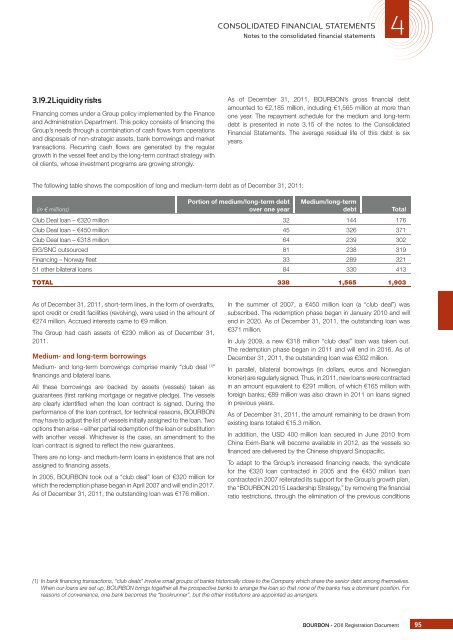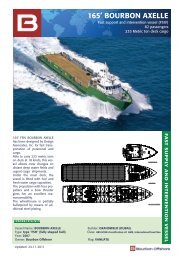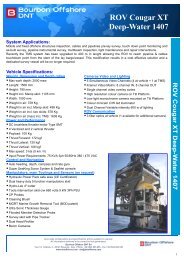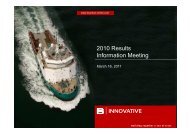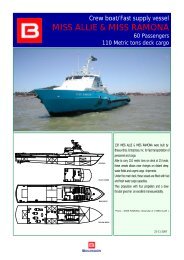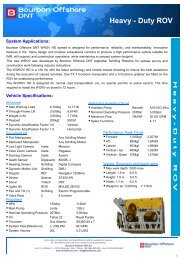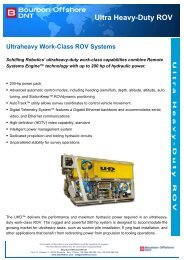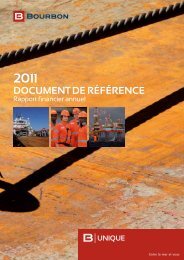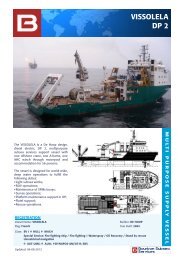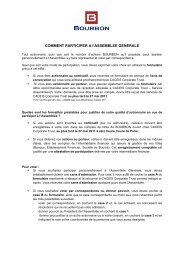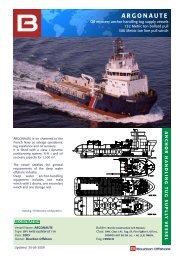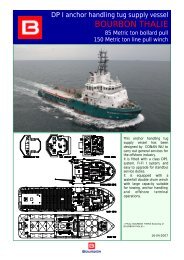REGISTRATION DOCUMENT - Bourbon
REGISTRATION DOCUMENT - Bourbon
REGISTRATION DOCUMENT - Bourbon
- No tags were found...
You also want an ePaper? Increase the reach of your titles
YUMPU automatically turns print PDFs into web optimized ePapers that Google loves.
CONSOLIDATED FINANCIAL STATEMENTS4Notes to the consolidated financial statements3.19.2 Liquidity risksFinancing comes under a Group policy implemented by the Financeand Administration Department. This policy consists of fi nancing theGroup’s needs through a combination of cash fl ows from operationsand disposals of non-strategic assets, bank borrowings and markettransactions. Recurring cash fl ows are generated by the regulargrowth in the vessel fl eet and by the long-term contract strategy withoil clients, whose investment programs are growing strongly.As of December 31, 2011, BOURBON’s gross fi nancial debtamounted to €2,185 million, including €1,565 million at more thanone year. The repayment schedule for the medium and long-termdebt is presented in note 3.15 of the notes to the ConsolidatedFinancial Statements. The average residual life of this debt is sixyears.The following table shows the composition of long and medium-term debt as of December 31, 2011:Portion of medium/long-term debtover one yearMedium/long-termdebt(in € millions)TotalClub Deal loan – €320 million 32 144 176Club Deal loan – €450 million 45 326 371Club Deal loan – €318 million 64 239 302EIG/SNC outsourced 81 238 319Financing – Norway fl eet 33 289 32151 other bilateral loans 84 330 413TOTAL 338 1,565 1,903As of December 31, 2011, short-term lines, in the form of overdrafts,spot credit or credit facilities (revolving), were used in the amount of€274 million. Accrued interests came to €9 million.The Group had cash assets of €230 million as of December 31,2011.Medium- and long-term borrowingsMedium- and long-term borrowings comprise mainly “club deal (1) ”fi nancings and bilateral loans.All these borrowings are backed by assets (vessels) taken asguarantees (fi rst ranking mortgage or negative pledge). The vesselsare clearly identifi ed when the loan contract is signed. During theperformance of the loan contract, for technical reasons, BOURBONmay have to adjust the list of vessels initially assigned to the loan. Twooptions then arise – either partial redemption of the loan or substitutionwith another vessel. Whichever is the case, an amendment to theloan contract is signed to refl ect the new guarantees.There are no long- and medium-term loans in existence that are notassigned to fi nancing assets.In 2005, BOURBON took out a “club deal” loan of €320 million forwhich the redemption phase began in April 2007 and will end in 2017.As of December 31, 2011, the outstanding loan was €176 million.In the summer of 2007, a €450 million loan (a “club deal”) wassubscribed. The redemption phase began in January 2010 and willend in 2020. As of December 31, 2011, the outstanding loan was€371 million.In July 2009, a new €318 million “club deal” loan was taken out.The redemption phase began in 2011 and will end in 2016. As ofDecember 31, 2011, the outstanding loan was €302 million.In parallel, bilateral borrowings (in dollars, euros and Norwegiankroner) are regularly signed. Thus, in 2011, new loans were contractedin an amount equivalent to €291 million, of which €165 million withforeign banks; €89 million was also drawn in 2011 on loans signedin previous years.As of December 31, 2011, the amount remaining to be drawn fromexisting loans totaled €15.3 million.In addition, the USD 400 million loan secured in June 2010 fromChina Exim-Bank will become available in 2012, as the vessels sofi nanced are delivered by the Chinese shipyard Sinopacifi c.To adapt to the Group’s increased fi nancing needs, the syndicatefor the €320 loan contracted in 2005 and the €450 million loancontracted in 2007 reiterated its support for the Group’s growth plan,the “BOURBON 2015 Leadership Strategy,” by removing the fi nancialratio restrictions, through the elimination of the previous conditions(1) In bank fi nancing transactions, “club deals” involve small groups of banks historically close to the Company which share the senior debt among themselves.When our loans are set up, BOURBON brings together all the prospective banks to arrange the loan so that none of the banks has a dominant position. Forreasons of convenience, one bank becomes the “bookrunner”, but the other institutions are appointed as arrangers.BOURBON - 2011 Registration Document 95


